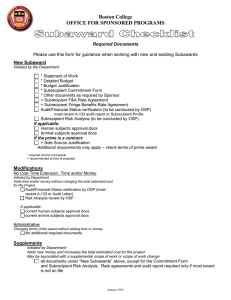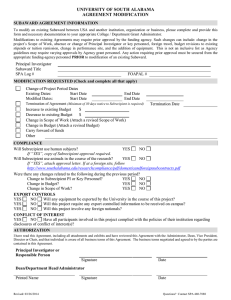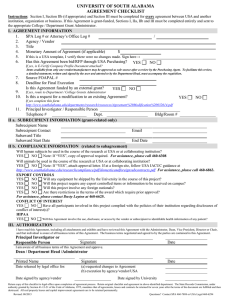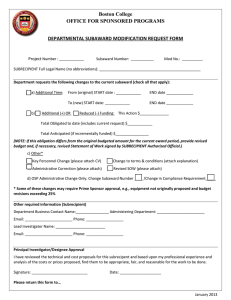Document 12120977
advertisement
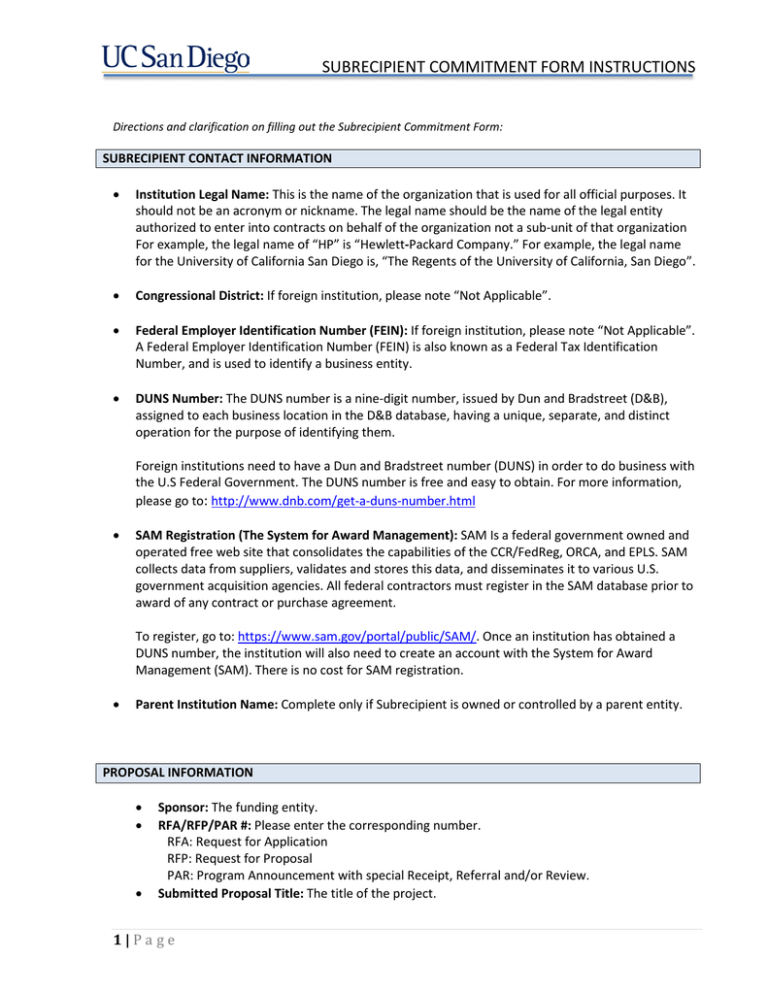
SUBRECIPIENT COMMITMENT FORM INSTRUCTIONS Directions and clarification on filling out the Subrecipient Commitment Form: SUBRECIPIENT CONTACT INFORMATION • Institution Legal Name: This is the name of the organization that is used for all official purposes. It should not be an acronym or nickname. The legal name should be the name of the legal entity authorized to enter into contracts on behalf of the organization not a sub-unit of that organization For example, the legal name of “HP” is “Hewlett-Packard Company.” For example, the legal name for the University of California San Diego is, “The Regents of the University of California, San Diego”. • Congressional District: If foreign institution, please note “Not Applicable”. • Federal Employer Identification Number (FEIN): If foreign institution, please note “Not Applicable”. A Federal Employer Identification Number (FEIN) is also known as a Federal Tax Identification Number, and is used to identify a business entity. • DUNS Number: The DUNS number is a nine-digit number, issued by Dun and Bradstreet (D&B), assigned to each business location in the D&B database, having a unique, separate, and distinct operation for the purpose of identifying them. Foreign institutions need to have a Dun and Bradstreet number (DUNS) in order to do business with the U.S Federal Government. The DUNS number is free and easy to obtain. For more information, please go to: http://www.dnb.com/get-a-duns-number.html • SAM Registration (The System for Award Management): SAM Is a federal government owned and operated free web site that consolidates the capabilities of the CCR/FedReg, ORCA, and EPLS. SAM collects data from suppliers, validates and stores this data, and disseminates it to various U.S. government acquisition agencies. All federal contractors must register in the SAM database prior to award of any contract or purchase agreement. To register, go to: https://www.sam.gov/portal/public/SAM/. Once an institution has obtained a DUNS number, the institution will also need to create an account with the System for Award Management (SAM). There is no cost for SAM registration. • Parent Institution Name: Complete only if Subrecipient is owned or controlled by a parent entity. PROPOSAL INFORMATION • • • Sponsor: The funding entity. RFA/RFP/PAR #: Please enter the corresponding number. RFA: Request for Application RFP: Request for Proposal PAR: Program Announcement with special Receipt, Referral and/or Review. Submitted Proposal Title: The title of the project. 1|Page SUBRECIPIENT COMMITMENT FORM INSTRUCTIONS • • Requested Amount: The amount of funding requested for the subrecipient including indirect costs. Performance Begin Date/End Date: Enter the entire project period. INSTITUTIONAL OFFICIAL APPROVAL • Proposal Checkbox: Signature required only if submitting the Subrecipient Commitment Form for a proposal. Signature not required if submitting for processing a Subaward Agreement. • Institutional Official’s Signature: Only an authorized official of the subrecipient should sign this form. The official’s signature indicates that he/she is authorized to provide this information and that he/she is prepared to commit the organization to the proposed project and abide by the policies of the sponsor if the project is funded. SECTION A – Proposal Checklist and Documents Check the boxes next to the documents and information that are relevant to your proposal: • Statement of Work (REQUIRED): This is a description of the scope of work to be performed by the subrecipient. The work performed should be a substantive and important part of the overall project—not just a supplementary service. • Budget and Narrative Budget Justification (REQUIRED): This refers to the costs associated with carrying out the subrecipient’s scope of work. The budget provides the financial information, and the budget justification provides an explanation of how these costs were determined. • Cost Sharing: When an organization pledges a cost sharing contribution to the project at the proposal stage it becomes a firm commitment when the award is made and committed cost share must be tracked and reported to the sponsor. For this reason, cost sharing should not be included in the proposal unless it is required by the sponsor. If your organization is committing cost share to the project please: o Provide cost-share amount on the form o Attach the cost-share documentation/commitment letter • Major Project Status: A “Major project” is defined as a project that requires an extensive amount of administrative or clerical support, which is significantly greater than the administrative services included as part of an organization’s indirect cost (F&A) rate. This designation must be carefully justified in the subrecipient’s budget justification. SECTION B – Subrecipient Eligibility 1 A-E. Debarment, Suspension, Proposed Debarment: People and organizations may be debarred (or excluded) from receiving U.S. federal financial and non-financial assistance. The questions in this section are designed to identify subrecipients that are unable to enter into a subagreement with UC San Diego. If any of the questions are answered in the affirmative, then do not complete the remainder of the form 2|Page SUBRECIPIENT COMMITMENT FORM INSTRUCTIONS and notify the UC San Diego PI and subawards@ucsd.edu as soon as possible. Please include an explanation for any affirmative answers. 2. Government Entity: U.S. federal government entities may not receive subawards if the Prime Sponsor is a U.S. federal government agency or entity. Other agreement types may apply; if you are a federal government entity, please contact subawards@ucsd.edu to discuss other options. Note: U.S. federal government entities may receive subawards if the Prime Sponsor is not a U.S. federal government entity. 3. Foreign Entity: If your institution is a Foreign Entity, please list the country/countries the organization is headquartered in, as well as the country where the preponderance of the project will take place in. 4. For-Profit/Commercial Entity: If Subrecipient is a for-profit or commercial entity and the goods and services provided will be comparable to the goods/services provided to a significant number of different customers, please describe how these goods and/or services will differ from those offered to other customers and any potential role as an inventor in the space provided. Note: Vendors are not subject to many of the flow-down provisions required of Subrecipients (e.g., effort reporting under a federal award). It is essential that the work provided by any for-profit/commercial Subrecipient be classified appropriately. Subrecipient Business Status (For-profit Organizations only): This section should only be used by for- profit organizations. Check the category that applies: • Small Business is organized for profit; has a place of business in the United States; makes a significant contribution to the U.S. economy through payment of taxes or use of American products, materials or labor; is independently owned and operated; is not dominant in its field, on a national basis; and is no larger than SBA’s small business size standard for its industry. A business can find the size standard for its industry by consulting the Small Business Administration’s Table of Size Standards. Small Business Classification (as *certified by the Small Business Administration): • • • HUB Zone Small Business* as used in this provision means a small business that appears on the list of Qualified HUB Zone Small Business maintained by the US Small Business Administration. Small Disadvantaged Business (SDB)* (8a)* as used in this provision means a small business that: (i) has received certification as a small disadvantaged business consistent with 13 CFR part 124, Subpart B; (ii) no material change in disadvantaged ownership and control has occurred since its certification; (iii) where the is owned by one or more individuals, the net worth of each individual upon whom the certification is based does not exceed $750,000, after taking into account the applicable exclusions set forth at 13 CFR 124.104(c)(2); and (iv) is identified, on the date of its representation, as a certified small disadvantaged business in PRO-Net, the database maintained by the Small Business Administration. Woman-Owned Small Business (WOSB) as used in this provision means a small business that: (i) is at least 51% unconditionally owned by one or more women; or in the case of any publicly owned business, at least 51% of the stock of which is unconditionally owned by one or more women; and (ii) whose management and daily business operations are controlled by one or 3|Page SUBRECIPIENT COMMITMENT FORM INSTRUCTIONS • • more women. Service-Disabled Veteran-Owned Small Business (SDVOSB) as used in this provision means a small business that: (i) is at least 51% unconditionally owned by one or more service-disabled veterans (as defined at 38 U.S.C. 101(2), with a disability that is service connected, as defined in 38 U.S.C. 101(16)); or in the case of any publicly owned business, at least 51% of the stock of which is unconditionally owned by one or more service-disabled veterans; and (ii) whose management and daily business operations are controlled by one or more service-disabled veterans or, in the case of a veteran with permanent and severe disability, the spouse or permanent caregiver of such veteran. Veteran-Owned Small Business (VOSB) is a small business that: (i) is at least 51% unconditionally owned by one or more veterans (as defined at 38 U.S.C. 101(2)); or in the case of any publicly owned business, at least 51% of the stock of which is unconditionally owned by one or more veterans; and (ii) whose management and daily business operations are controlled by one or more veterans. SECTION C – Budget and Rates 1. Facility and Administration (F&A) Rate: This is the percentage of the project’s direct costs that an organization may charge the sponsor for the “indirect” costs associated with housing and managing a sponsored project. Such costs include utilities costs and administrative time and effort to support the project. These costs also are sometimes referred to as “overhead.” • • A “federally negotiated F&A rate:” This means that an agency of the U.S. federal government has reviewed the organization’s indirect cost proposal and has agreed in writing that the organization may charge the U.S. federal government a certain percentage of direct project costs for F&A (indirect) costs. If your organization has an F&A rate approved by a U.S. federal agency, please attach a copy of your F&A agreement to the Subrecipient Commitment form or provide a webpage link to this information. Other Rates: If your organization does not have a U.S. federally negotiated F&A rate, and plans to charge for indirect costs, please attach an explanation as to how this rate was derived. The rates may be based on specific solicitation guidance/agency requirements; Defense Contract Audit Agency (DCAA) approved rates; or Other. Please note: International organizations typically do not receive reimbursement for F&A costs from the U.S. federal government unless the foreign organization has negotiated an F&A rate agreement with a U.S. federal agency. A U.S. federal sponsor also may have a policy of paying a specific F&A rate to foreign and international organizations. 2. Fringe Benefit Rates: Fringe benefit rates include the percentage of salary and/or the amount your organization pays for employee retirement, health insurance, Medicare, and Social Security, etc. It represents the employer’s contribution to these costs—not the employee’s contribution. • Composite/Other Rates: Some organizations negotiate their fringe benefit rates with the U.S. federal government just as they do their F&A rate. Other organizations use actual rates for each employee. Still others use composite rates for different classes of employees. For this section, indicate how the fringe benefit rates were calculated. Attach a copy of the fringe benefit information to the form , provide a link to this information on your organization’s webpage, or 4|Page SUBRECIPIENT COMMITMENT FORM INSTRUCTIONS provide an explanation in Section F - Comments 3. Actual Costs: This question is to identify subrecipients that do not have support for cost elements they are requesting. If answered “NO”, please contact subawards@ucsd.edu and the PI immediately. “NO” to Question 3 will not automatically exclude your organization from participating in this proposed project; it will require UC San Diego to conduct an assessment before making a decision to enter into a subagreement with your organization. Example: It is an existing base salary multiplied by hours or percent of effort, and a verifiable fringe benefit rate. If the prime award is a grant or cooperative agreement, no profit may be realized or retained by Subrecipient and no profit should be included in Subrecipient’s proposal. If this proposal is under a prime contract, any profit and fees are broken out separately. The UC San Diego Subawards team may determine if subawardee is truly a vendor, and may proceed with the entity as a vendor if loaded rates are present on the budget at time of proposal. NIH Guide notice NOT-OD-15-017. SECTION D – Audit Status Any non-profit entity that has expended at least $500,000 in U.S. federal funds within the organization’s previous fiscal year is subject to the Circular A-133 single audit requirement with the exception of foreign organizations. For-profit organizations and U.S. federal government agencies also are not subject to A-133 audit requirements. • Agencies subject to A-133 requirements should attach a description of any findings or exceptions noted in their most recently completed A-133 audit. An update of this information may be requested prior to establishing a subagreement with your organization. • Organizations not subject to A-133 audit requirements will be required to confirm that the organization still is not subject to A-133 audit requirements and fill out the Mini-Audit Questionnaire prior to the establishment of a subagreement. • Please note: When applying for funds from agencies under the U.S. Department of Health and Human Services foreign organizations and for-profits that have expended a total of $500,000 or more under one or more awards from the U.S. Department of Health and Human Services (as a direct grantee and/or under a consortium participant) will be required to have a financialrelated audit of all HHS awards as defined in, and in accordance with, the Government Auditing Standards or an audit that meets the requirements of OMB Circular A-133. SECTION E – Research Compliance 5|Page SUBRECIPIENT COMMITMENT FORM INSTRUCTIONS 1. Human Subjects: If your organization will be carrying out human subjects’ research under the subagreement with UC San Diego mark, “Yes,” on the form. Please provide your organization’s Office of Human Research Protection (OHRP) approved Federal Wide Assurance (FWA) number. If your organization does not have an FWA #, provide an explanation as to how your organization will comply with U.S. federal regulations and policies for the protection of human subjects. In accordance with UC San Diego policy, UC San Diego’s IRB must conduct a secondary review of the subaward work and issue a companion approval before any subaward will be issued. 2. Animal Subjects: If your organization will be carrying out animal research under the subagreement with UC San Diego mark, “Yes,” on the form. Note: The UCSD IACUC must review and approve your organization’s animal research protocol before a subagreement will be issued. If your organization does not have a PHS Animal Welfare Assurance (OLAW) number, provide an explanation as to how your organization will comply with U.S. federal regulations and policies for the protection of animal subjects. In accordance with UC San Diego policy, UC San Diego’s IACUC must conduct a secondary review of the subaward work and issue a companion approval before any subaward will be issued. 3. Conflict of Interest: Complete this section only if the Prime proposal is being submitted to any of the following sponsors (check FDP FCOI link for most updated list): Public Health Service (PHS) Agencies (updated 9/15/2015) 1. 2. 3. 4. 5. 6. 7. 8. 9. 10. 11. 12. 13. Agency for Healthcare Research and Quality (AHRQ) Agency for Toxic Substances and Disease Registry (ATSDR) Centers for Disease Control and Prevention (CDC) Food and Drug Administration (FDA) Health Resources and Services Administration (HRSA) Indian Health Service (IHS) National Institutes of Health (NIH) Office of Global Affairs (OG) Office of the Assistant Secretary for Health (OASH) Office of the Assistant Secretary for Planning and Evaluation Office of the Assistant Secretary for Preparedness and Response (ASPR) Office of Public Health and Science Substance Abuse and Mental Health Services Administration (SAMHSA) Non-PHS Agencies (updated 3/10/2015) 1. 2. 3. 4. 5. 6. 7. 6|Page Alliance for Lupus Research (ALR) Alpha-1 Foundation American Asthma Foundation American Cancer Society (ACS) American Heart Association (AHA) American Lung Association (ALA) Arthritis Foundation (AF) SUBRECIPIENT COMMITMENT FORM INSTRUCTIONS 8. 9. 10. 11. 12. CurePSP Juvenile Diabetes Research Foundation (JDRF) Lupus Foundation of America (LFA) Patient-Centered Outcomes Research Institute (PCORI) Susan G. Komen for the Cure 4. Dual Use Research of Concern (DURC) If at least one box is checked a copy of your Institutions Review Entity determination as to whether the research qualifies as DURC must be provided. Once we receive it and it is determined by PHS/NIH that the research is in fact DURC, a copy of the mitigation plan must be provided to UCSD before any subaward will be issued. Please forward these documents to subawards@ucsd.edu as soon as they become available. Please indicate the UCSD Principal Investigator’s name for reference. For more information please see SECTION F – Comments To be used for providing additional explanation or documentation. 7|Page
